In recent years, the number of international students has been increasing worldwide. For instance, according to UNESCO data, from 2015 to 2019, the number of international students increased from 4.8 million to 6.1 million. Moreover, studies have illustrated that international students, directly and indirectly, contribute to the host countries’ economies through tuition fees, living costs, transportation, travel, and other aspects. In this issue, we overview the dynamics of foreign students in Georgia and their financial contribution to the country’s educational sector.
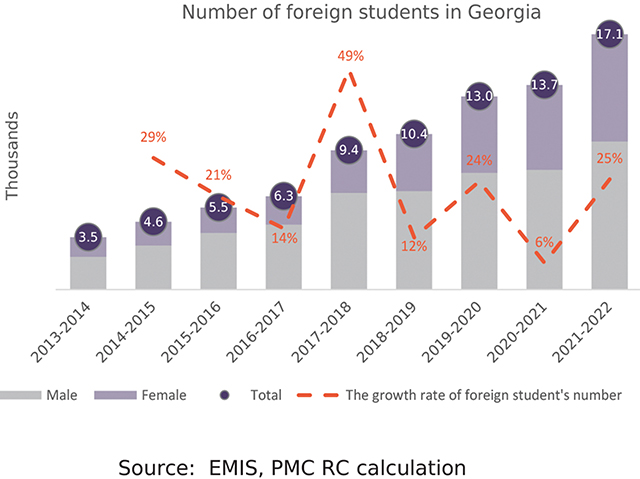
Number of foreign students in Georgia
In recent years, there has been a rise in the number of foreign students in Georgia. From the 2013-2014 academic year to the 2021-2022 academic year, their number increased from 3,525 to 17,139, indicating an average annual growth rate of 22%.
The share of foreign students among the total number of students in Georgia has also grown noticeably over the same period, going from 2.9% to 10.3%.
In comparison to other countries’ foreign students dynamics, Georgia’s increase in its inbound mobility rate has been significant. To clarify, the inbound mobility rate is a UNESCO indicator, defined as the number of students from abroad studying in a given country, expressed as a percentage of total tertiary enrolment in that country. From 2015 to 2019, Georgia’s score for the inbound mobility rate indicator increased from 3.7 points to 8.1. In 2019, Georgia ranked 32nd out of 94 countries, rising notably from 55th place in 2015.
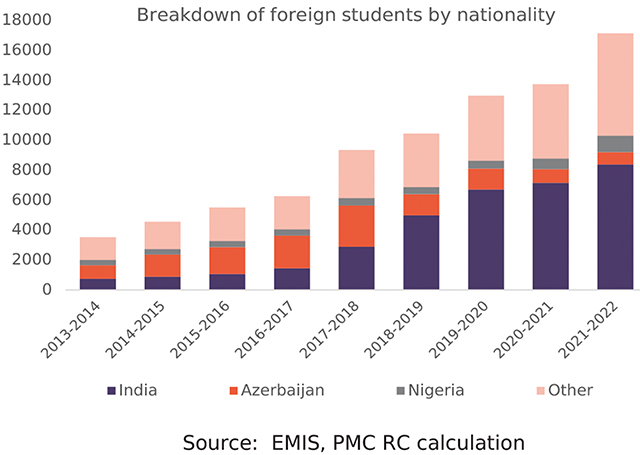
Breakdown of foreign students by nationality
A breakdown of the number of foreign students in Georgia by nationality reveals that from the 2013-2014 academic year to the 2016-2017 academic year, the highest share came from Azerbaijan, averaging 31% during this period. However, from the 2017-2018 academic year to the 2021-2022 academic year, the number of students from Azerbaijan shrank rapidly, with an annual growth rate of -24%. Meanwhile, from the 2016-2017 academic year to the 2021-2022 academic year, the share of students from India significantly increased. Specifically, during this period the share of Indian students increased by 22 percentage points and amounted to 53%.
It is also worth noting that the number of students from North America, the UK, and the EU grew during the analyzed period. For instance, from the 2013-2014 academic year to the 2021- 2022 academic year, the number of students from this combined geographical area increased from 37 to 435 (3% of all foreign students).
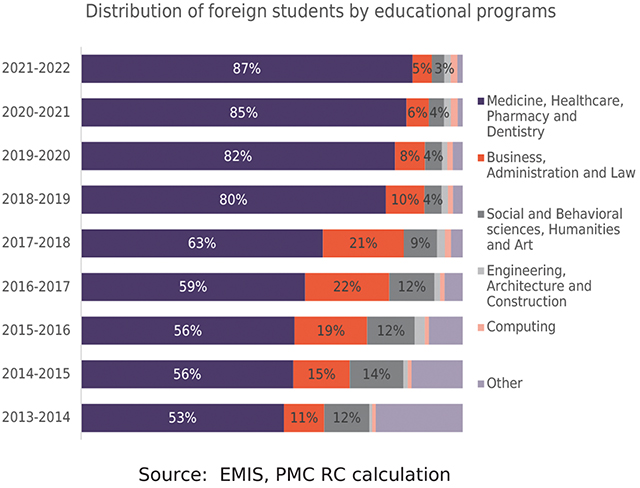
Distribution of foreign students by educational programs
To gain a broader picture of foreign students dynamics it is important to observe their distribution by educational program as well. The share of foreign students taking medicine, healthcare, pharmacy, and dentistry increased significantly from the 2013- 2014 academic year to the 2021-2022 academic year.
Indeed, overall growth amounted to 34 percentage points over this period and amounted to 87%. This category’s share increased every academic year, with the most noticeable rise coming from the 2017-2018 academic year to the 2018-2019 academic year (17 percentage points).
Meanwhile, the share of students studying business, administration, and law also witnessed growth from the 2013-2014 academic year to the 2016-2017 academic year. However, share of this category started shrinking from the 2017-2018 academic year and stood at 5% as of the 2021-2022 academic year. The most noticeable decrease in this period was recorded during the 2018-2019 academic year (11 percentage points). Meanwhile, the share of social and behavioral sciences, humanities, and arts also witnessed a decline. From the 2013-2014 academic year to the 2021-2022 academic year, the share has decreased from 12% to 3%.
It is worth noting that the growth of the share of medicine, healthcare, pharmacy, and dentistry students was determined by an increased number of Indian students as the majority of them are studying in this category.
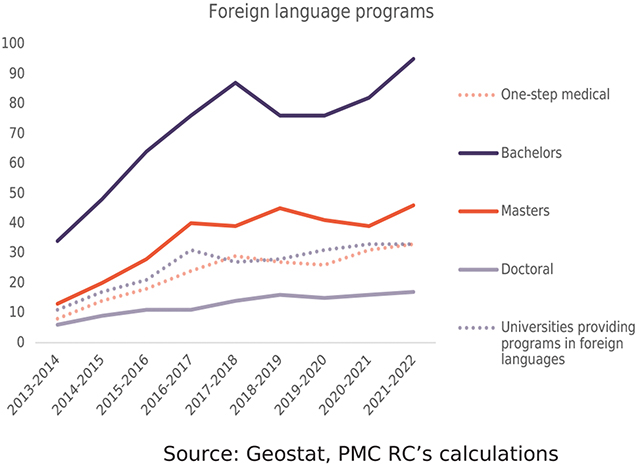
Foreign language programs
With the growth in the number of foreign students in Georgia, the number of foreign-language educational programs has also increased in Georgian universities.
For instance, from the 2013-2014 academic year to the 2021-2022 academic year, the number of foreign-language programs increased from 61 to 191. The majority of them (165) are in English, with 23 in Russian, 2 in French, and 1 in German. The growth in the number of programs is noticeable at every academic level. From the 2013-2014 academic year to the 2021-2022 academic year, the number of bachelors programs increased from 34 to 95, masters programs rose from 13 to 46, and doctoral programs soared from 6 to 17. Pertinently, one-step medical programs witnessed the highest growth, more than quadrupling from 8 to 33.
It is also worth noting that over the analyzed period, the number of universities providing foreign-language programs tripled from 11 to 33.
In the academic year of 2021-2022, the distribution of foreign language programs in which foreign students are enrolled is as follows: medicine-related fields – 27%; business, management, and law – 26%; social and behavioral sciences, humanities and arts – 17%; engineering, architecture and construction – 12%, computer science – 9%; other fields – 9%. Moreover, the breakdown of foreign students across these programs is as follows: medicine-related fields – 89%; business, management, and law – 5%; social and behavioral sciences, humanities and arts – 2%; architecture and construction – 2%, computer science -1%; and other fields – 1%. Thus, the distribution of students across fields is unequal.
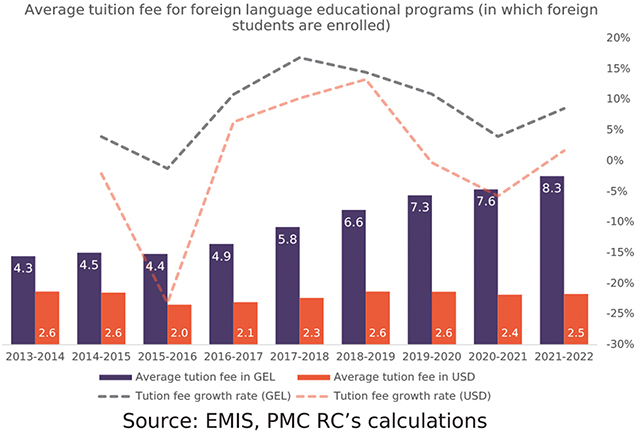
Average tuition fee for foreign language educational programs (in which foreign students are enrolled)
From the 2013-2014 academic year to the 2021-2022 academic year, tuition fees for foreign-language educational programs, in which foreign students were enrolled, nearly doubled, from GEL 4,300 to GEL 8,300. The annual growth rate over this period amounted to 9%.
Despite the increase in tuition fees in GEL, these have not increased in USD. In fact, over the analyzed period this decreased from USD 2,600 to USD 2,500. Hence, the increase in tuition fees in GEL was strongly determined by the depreciation of the Georgian Lari.
In the 2021-2022 academic year, the highest average tuition fees are for medicine, healthcare, pharmacy and dentistry programs (GEL 11,521), followed by computing (GEL 8,960). Meanwhile, the lowest tuition fees are for social and behavioral sciences, humanities, and arts (GEL 4,660).
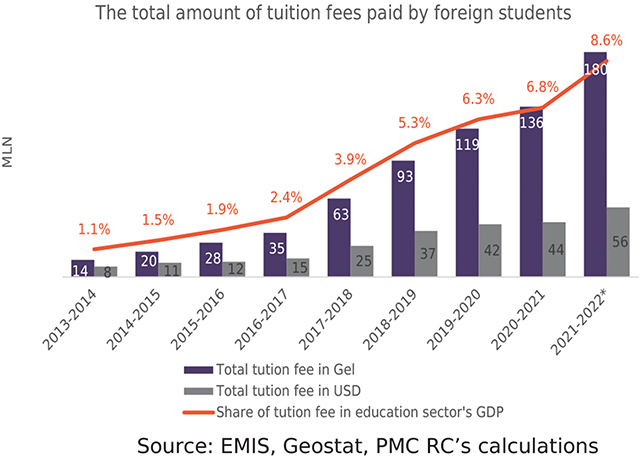
The total amount of tuition fees paid by foreign students
The total amount of tuition fees paid by foreign students and its share in the education sector’s GDP has been steadily increasing since the 2013-2014 academic year.
From the 2013-2014 academic year to the 2021-2022 academic year, the total amount of tuition fees paid by foreign students increased from GEL 14 million to GEL 180 million, with an average annual growth rate of 39%. However, the increase in the total amount of tuition fees has not been as significant in USD as it has been in GEL. Over the analyzed period, the total amount of tuition fees paid increased from USD 8 million to USD 56 million, indicating an average annual growth rate of 29%.
As the number of total tuition fees paid increased over the analyzed period, its share in the education sector’s GDP also grew steadily. From the 2013-2014 academic year to the 2021-2022 academic year, this share increased from 1.1% to 8.6%. In terms of total GDP, over the analyzed period, the share increased from 0.05% to 0.36%.
Overall, foreign students’ interest in studying in Georgia has been rising rapidly in recent times. Due to this increased demand, Georgian universities have started to increase the number of educational programs in foreign languages accordingly. Along with the growing number of foreign students, their financial contribution to Georgian higher education has also increased. However, the increased interest is becoming more homogenous as the vast majority of students are choosing medical programs and most of them are from India. An apparently emerging dependence on the medical field and Indian students might create some challenges in the future. With this in mind, the Georgian higher education system should put more effort toward attracting students from different countries and increase interest, of foreign students, in other academic fields besides medicine.
![]()














